Text
Puerto Rican Rock Art, Part 2
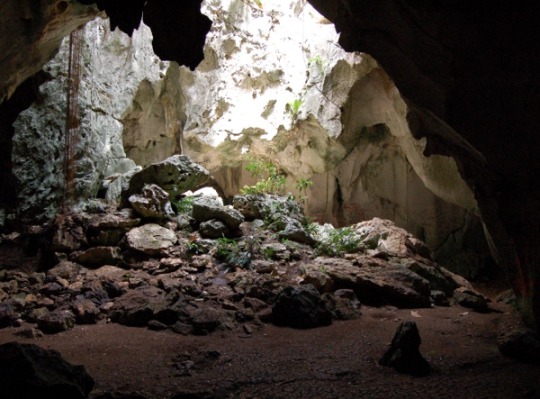
Hello and welcome to part 2 of my Puerto Rican Rock Art project! I will mostly be talking about Cueva Lucero (pictured above). I may mention other caves as well, just because there aren't many papers written about this specific cave. There are many others since about 81% of rock art found on the island is found in caves (Dubelaar 1994). I imagine it's just easier to talk about all the caves as a whole since they were all used similarly.
Cueva Lucero can be found in Juana Diaz in Puerto Rico. (Not from references).

However, due to fears of vandalism, the cave's exact location isn't listed in the National Register of Historic Places. In this same form, Cueva Lucero is deemed as important due to all the art found in it, this art shows us a part of the past we could have never seen without it. It is thought to be a place of religion or as a ceremonial site (Rodriguez et al, 2008). This cave was used around 600-1500 C.E., and represents mostly pre-Hispanic times and contains around 100 rock art images. That makes itself one of the best examples of pictographs in Puerto Rico (Rodriguez et al, 2008). While it has plenty of pictographs, it has petroglyphs as well.
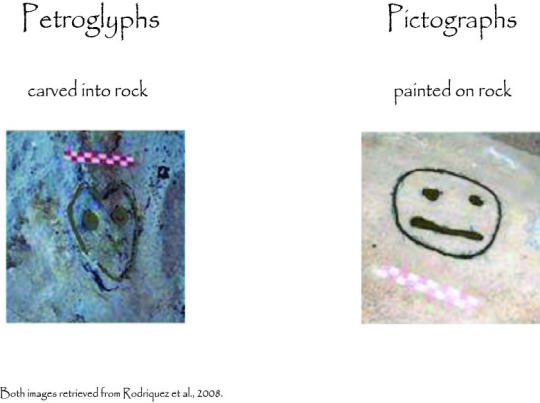
The difference between petroglyphs and pictographs are that one is painted, and one is carved imagery. I included an example above.
There are three different types of landscapes that both these styles show up in:
A. Caves and rock shelters on the coast, created by the waves.
B. Caves and rock shelters found in the mountains.
C. Riverbanks and riverbeds.
As well, Puerto Rico has an extra type:
D. The petroglyphs found in Puerto Nuevo. They are engraved in flat sandstone ledge that run parallel to the coast (Dublelaar 1994). Pictured below.
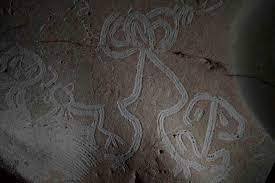

Rock paintings found in Puerto Rico can be monochrome, bichrome and polychrome (Dubelaar 1994). They also can be found in a couple colors as well. Red, white, orange and black were most commonly used (Hayward et. al., 2009).
Cueva Lucero falls under type B, has most, if not, only monochrome paintings. Most are painted using the color black.



Here, you also see a lot of circles being used in their art. Obviously, using circles so much does suggest that the shape has importance for the community (Fewkes 1903). It can be seen as a sign of unity, which, is found in many other indigenous communities. Here are some examples of circle art found in Cueva Lucero.
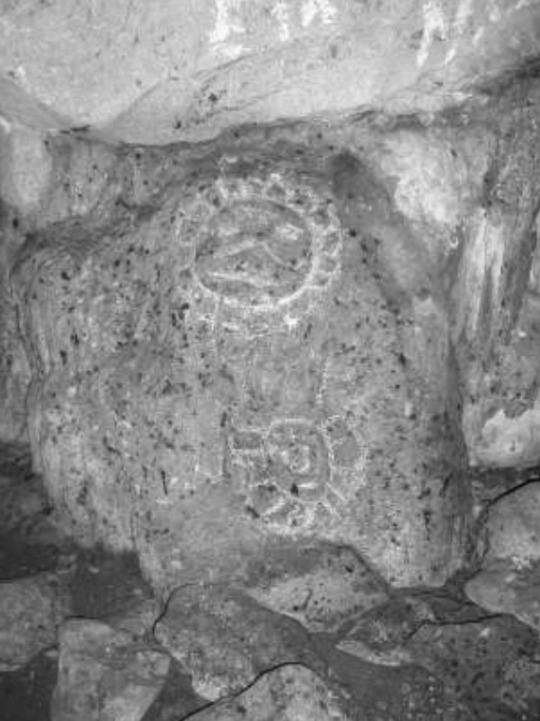




Lots of circles.

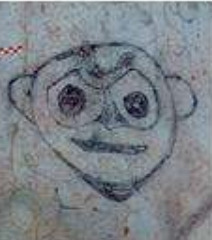
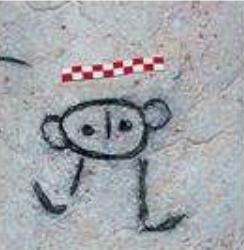
That is about it for this cave. Cueva Lucero holds valuable knowledge about the past. Without it, the other caves, we wouldn't have been able to obtain as much knowledge from our Taino ancestors as we do now. This goes to show, these old paintings and carvings, sites we find on the island (sites where people lived, hunting sites), are vital to understanding our history.
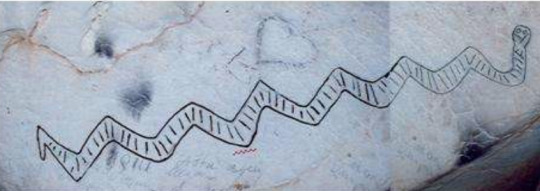
All photos (unless otherwise stated) are pictures from Cueva Lucero. All but the very first photo are from Rodriguez et al. 2008.
My references:
Dubelaar, C. N. 1994. Prehistoric rock art in Puerto Rico. Latin American Indian Literatures Journal, 10(1): 78–82.
Fewkes, J. Walter. “Prehistoric Porto Rican Pictographs.” American Anthropologist 5, no. 3 (1903): 441–67. http://www.jstor.org/stable/659123.
Hayward, M. H., Roe, P. G., Cinquino, M. A., Alvarado Zayas, P. A. and Wild, K. S. 2009. “Rock art of Puerto Rico and the Virgin Islands”. In Rock Art of the Caribbean, Edited by: Hayward, M. H., Atkinson, L. G. and Cinquino, M. A. 115–136. Tuscaloosa: University of Alabama Press.
Lace, Michael J. “Anthropogenic Use, Modification, and Preservation of Coastal Cave Resources in Puerto Rico.” The Journal of Island and Coastal Archaeology, vol. 7, no. 3, 2012, pp. 378–403., https://doi.org/10.1080/15564894.2012.729011.
Rodriguez, Yasha N. and Pedro Alvarado Zayas. 2008. "Cueva Lucero." National Register of Historic Places Registration Form. On file at Puerto Rico State Historic Preservation Office at San Juan, Puerto Rico.
Rouse, I. 1992. The Tainos: Rise and Decline of the People Who Greeted Columbus, New Haven: Yale University.
#archaeology#anthropology#cave#cave art#cave paintings#art#rock art#taino#indigenous peoples#pictographs#petroglyphs#colonialism#colonialization#university#school project#blog#puerto rico#grug#monochrome#mountain#caribbean#circles#frog#bird#references#little guys
29 notes
·
View notes
Text
Puerto Rican Rock Art, Part 1

Hello there! Welcome to my first blog post! I’m doing this for my final project for one of my classes. We all got to choose a specific archaeology site that we had to research. We had the choice of making a podcast, an essay, food, art, anything! I chose blogging, and TODAY!! We will be talking about a site in Puerto Rico. It is called Cueva Lucero, or Star Cave (pictured above). I will be having citations and my references at the end of the last blog post for this topic.
Before we get into the cave and Puerto Rico’s cave systems, we will go over the geography and brief history of Puerto Rico.
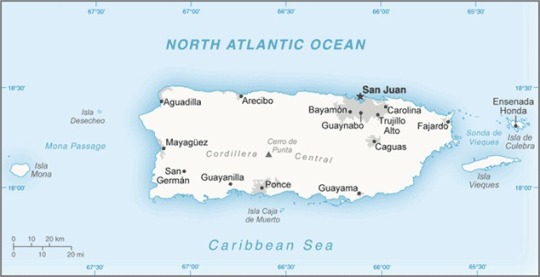
Puerto Rico is part of the “Greater Antilles” (Lace 2012). This is an area composed of a grouping of larger islands such as; the Cayman Islands, Cuba, Hispaniola, Jamaica and Puerto Rico. There is also a grouping called the “Lesser Antilles”, this group is composed of the smaller islands in the Caribbean.

The island first became inhabited between 430 BCE and 1000 CE. To us, they become known as the Taino people, and many other places in South America and the Caribbean were inhabited by them as well. Then along came Christopher Columbus and crew in 1493, and they brought plenty of diseases and exploitation of the native people to bring the indigenous population down. During this time, the Spanish worked on converting the Taino to Christianity. In fact, we can see some of that influence in post-Colonial art depictions in the cave systems (Rouse 1992). (seen below).

And, for a brief moment, lets not forget, the Taino people introduced to the world sweet potatoes, beans, squash, and peanuts (Rouse 1992).
The Spanish empire kept quite a hold on Puerto Rico for centuries, until, in 1898, the Spanish-American war happened. Puerto Rico was invaded and was turned over to the United States. In 1917, Puerto Ricans were granted U.S citizenship and still remain today as a commonwealth of America.
This was a very very brief history of Puerto Rico. In the 2nd part, we will be diving right in to Cueva Lucero and other cave systems! That part should be up now. And remember, all the references I use will be found in the 2nd part of this series.
Thank you for reading!
#anthropology#archeaology#history#puerto rico#cave#indigenous peoples#taino#pictographs#petroglyphs#art#rock art#cave art#cave paintings#caribbean#school project#university#blog#grug might live here#christianity#colonialism#christopher columbus#in 1492 christopher columbus sailed the ocean blue#1490s
19 notes
·
View notes